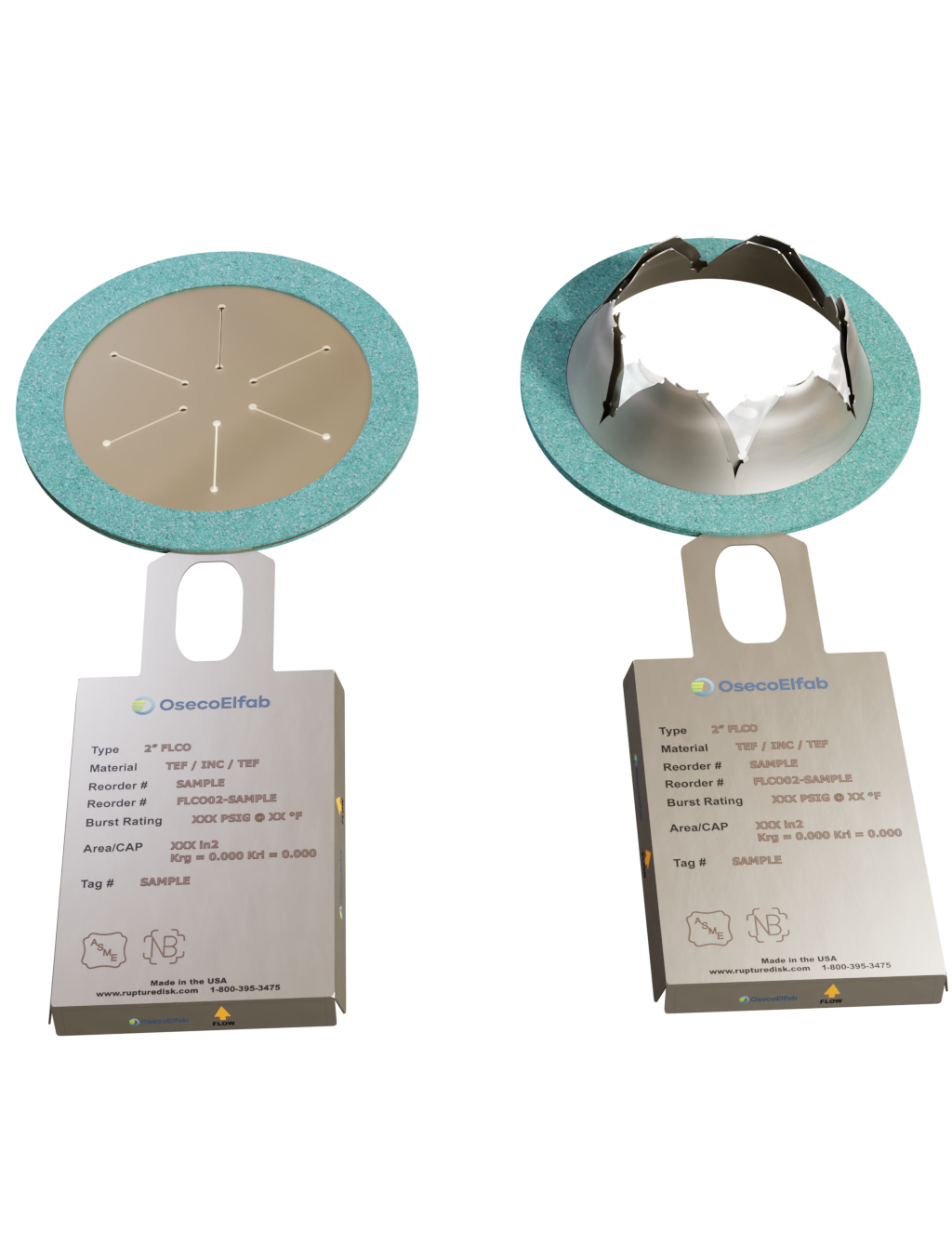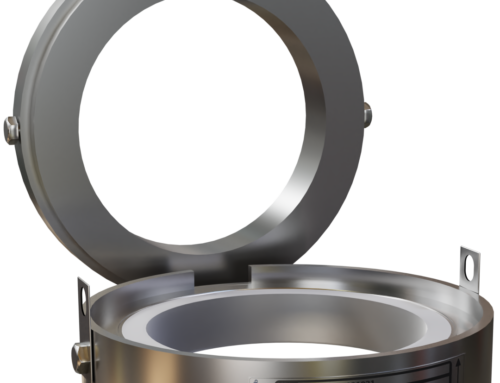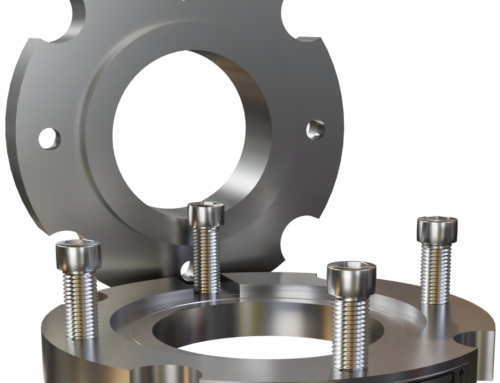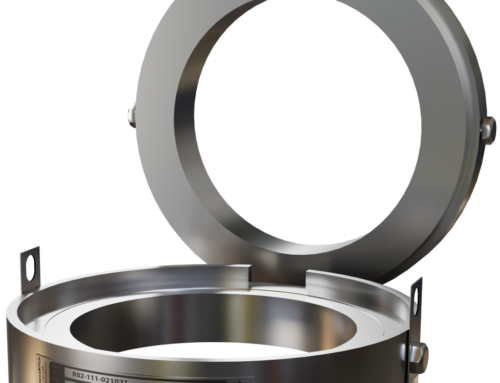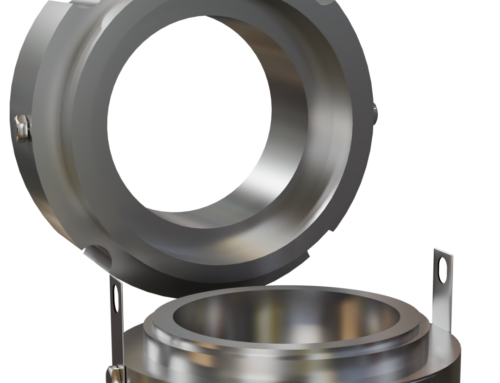OsecoElfab’s FLCO Rupture Disc
The FLCO, or Flat Composite, rupture disc is a simple, bi-directional pressure relief device that offers an economical solution for a wide range of applications. With sizes ranging from 2” to 36”, the FLCO is ideal for applications that need an easy, inexpensive pressure safety device. The design is called a “composite” because it always incorporates at least three distinct layers: a metal slotted center section (which controls the burst pressure), surrounded on both sides by slit-slot Teflon cover layers (which separates the metal above from the seal below), surrounded by outer, solid fluoropolymer seals (a solid sheet which holds back the process fluid and prevents leakage). Finally, flexible gaskets are glued and stapled to the outside of the assembly, as the FLCO does not require an external holder and is intended to install directly into an ANSI RF or FF flange joint. The FLCO is designed for operation in applications where normal system pressures do not exceed 50% of the stamped burst pressure.
- The FLCO is available in line sizes ranging from 2 inch diameter all the way up to 36 inches diameter.
- The FLCO is available in burst pressures ranging from 1 psig all the way up to 100 psig.
- The FLCO is available in burst temperatures ranging from cryogenic temperatures all the way up to 425 degrees F.
- The FLCO is available in all OE standard materials (316 Stainless Steel, Nickel 200, Inconel 600, Monel 400, and Hastelloy C 276). Other materials may be available or offered on request.
- The FLCO is available with Klingersil C-4401 gaskets as a standard, and other gasket materials are available upon request.
- The FLCO works well in gas or vapor services, as well as liquid or two-phase services.
- The FLCO is not ASME UD stamped. A default Kr value of 2.4 must be used when performing sizing calculations with this rupture disk.
- The FLCO has a 50% operating ratio, meaning the FLCO operates reliably and with a long service life at pressures up to 50% of the marked burst pressure. Pressure excursions above this 50% operating ratio will shorten the lifespan of the FLCO.
- The FLCO is offered with a standard 0% Manufacturing Design Range (MDR), meaning there will never be any variation between what burst pressure you order, and what burst pressure is marked on the tag of the rupture disk.
- The FLCO uses a custom burst tolerance of +/- 10% of marked burst pressure at pressure above 40 psig. For marked burst pressures between 21 psig and 40 psig, the FLCO uses a custom burst tolerance of +/- 4 psig, and at marked burst pressures between 5 psig and 20 psig, the FLCO uses a custom burst tolerance of +/- 2 psig. At marked burst pressures below 4 psig, the FLCO uses a custom burst tolerance of +2 psig.
- The FLCO is a non-scored metal rupture disk, with potential for fragmentation. This means the FLCO, and composite rupture disks in general, cannot and should not be installed upstream from a pressure relief valve.
- The FLCO is not offered with a vacuum support and is not designed to withstand vacuum pressures beyond 50% of the marked burst pressure.
- The FLCO is designed to be installed directly into an ANSI flange joint with raised facings or flat facings. No holder is required to use the FLCO rupture disk.
- The overall height of the FLCO from line sizes 2 inch through 10 inch is only 1/8 inch tall. From line sizes 12 inch through 36 inch, the FLCO is 3/16” tall.
- The FLCO is a flat, bi-directional metal rupture disk. Process pressure is applied to either side of the rupture disk. Increasing process pressure stretches the metal center section of the rupture disk until the metal yields and tears open between the holes drilled into the disk.
- The FLCO, like all flat, metal rupture disks, does best in static pressure applications. The FLCO handles pressure cyclic services fairly well, but reverse acting metal rupture disks are typically recommended, to ensure the tag stays attached to the disk for services with oscillating pressures.
- The FLCO is offered with an integrated burst detection sensor. This configuration is called the FLCOS, the S indicating a sensor has been added to the rupture disk.
- The FLCO is not designed, manufactured, nor certified to ASME BPVC Section XIII requirements.
- The factory must be consulted for MNFA values for the FLCO rupture disk.
- For a 2” FLCO, the combined burst pressure range for all the standard OE materials (316 Stainless Steel, Nickel 200, Inconel 600, Monel 400, and Hastelloy C 276) runs from 10 psig up to a maximum burst pressure of 100 psig.
- For a 2.5” FLCO, the combined burst pressure range for all the standard OE materials (316 Stainless Steel, Nickel 200, Inconel 600, Monel 400, and Hastelloy C 276) runs from 8 psig up to a maximum burst pressure of 80 psig.
- For a 3” FLCO, the combined burst pressure range for all the standard OE materials (316 Stainless Steel, Nickel 200, Inconel 600, Monel 400, and Hastelloy C 276) runs from 7 psig up to a maximum burst pressure of 70 psig.
- For a 4” FLCO, the combined burst pressure range for all the standard OE materials (316 Stainless Steel, Nickel 200, Inconel 600, Monel 400, and Hastelloy C 276) runs from 5 psig up to a maximum burst pressure of 55 psig.
- For a 6” FLCO, the combined burst pressure range for all the standard OE materials (316 Stainless Steel, Nickel 200, Inconel 600, Monel 400, and Hastelloy C 276) runs from 3 psig up to a maximum burst pressure of 40 psig.
- For an 8” FLCO, the combined burst pressure range for all the standard OE materials (316 Stainless Steel, Nickel 200, Inconel 600, Monel 400, and Hastelloy C 276) runs from 3 psig up to a maximum burst pressure of 30 psig.
- For a 10” FLCO, the combined burst pressure range for all the standard OE materials (316 Stainless Steel, Nickel 200, Inconel 600, Monel 400, and Hastelloy C 276) runs from 3 psig up to a maximum burst pressure of 25 psig.
- For a 12” FLCO, the combined burst pressure range for all the standard OE materials (316 Stainless Steel, Nickel 200, Inconel 600, Monel 400, and Hastelloy C 276) runs from 3 psig up to a maximum burst pressure of 22 psig.
- For a 14” FLCO, the combined burst pressure range for all the standard OE materials (316 Stainless Steel, Nickel 200, Inconel 600, Monel 400, and Hastelloy C 276) runs from 3 psig up to a maximum burst pressure of 20 psig.
- For a 16” FLCO, the combined burst pressure range for all the standard OE materials (316 Stainless Steel, Nickel 200, Inconel 600, Monel 400, and Hastelloy C 276) runs from 3 psig up to a maximum burst pressure of 18 psig.
- For an 18” FLCO, the combined burst pressure range for all the standard OE materials (316 Stainless Steel, Nickel 200, Inconel 600, Monel 400, and Hastelloy C 276) runs from 1 psig up to a maximum burst pressure of 16 psig.
- For a 20” FLCO, the combined burst pressure range for all the standard OE materials (316 Stainless Steel, Nickel 200, Inconel 600, Monel 400, and Hastelloy C 276) runs from 1 psig up to a maximum burst pressure of 14 psig.
- The FLCO is not currently offered in a 22″ line size.
- For a 24” FLCO, the combined burst pressure range for all the standard OE materials (316 Stainless Steel, Nickel 200, Inconel 600, Monel 400, and Hastelloy C 276) runs from 1 psig up to a maximum burst pressure of 12 psig.
- For a 28” FLCO, the combined burst pressure range for all the standard OE materials (316 Stainless Steel, Nickel 200, Inconel 600, Monel 400, and Hastelloy C 276) runs from 1 psig up to a maximum burst pressure of 11 psig.
- For a 30” FLCO, the combined burst pressure range for all the standard OE materials (316 Stainless Steel, Nickel 200, Inconel 600, Monel 400, and Hastelloy C 276) runs from 1 psig up to a maximum burst pressure of 10 psig.
- For a 32” FLCO, the combined burst pressure range for all the standard OE materials (316 Stainless Steel, Nickel 200, Inconel 600, Monel 400, and Hastelloy C 276) runs from 1 psig up to a maximum burst pressure of 10 psig.
- For a 36” FLCO, the combined burst pressure range for all the standard OE materials (316 Stainless Steel, Nickel 200, Inconel 600, Monel 400, and Hastelloy C 276) runs from 1 psig up to a maximum burst pressure of 10 psig.

